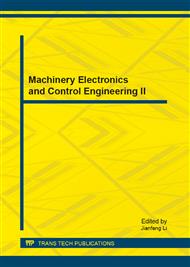p.412
p.418
p.422
p.427
p.432
p.438
p.443
p.448
p.453
Stabilizing Gain Regions of PID Controller for Time Delay Systems
Abstract:
Based on the inverse Nyquist plot, this paper proposes a method to determine stabilizing gain regions of PID controller for time delay systems. According to the frequency characteristic of the inverse Nyquist plot, it is confirmed that the frequency range is used for stability analysis, and the abscissas of two kind key points are obtained in this range. PID gain is divided into several regions by abscissas of key points. Using an inference and two theorems presented in the paper, the stabilizing PID gain regions are determined by the number of intersections of the inverse Nyquist plot and the vertical line in the frequency range. This method is simple and convenient. It can solve the problem of getting the stabilizing gain regions of PID controller for time delay system.
Info:
Periodical:
Pages:
432-437
Citation:
Online since:
March 2013
Authors:
Price:
Сopyright:
© 2013 Trans Tech Publications Ltd. All Rights Reserved
Share:
Citation:


